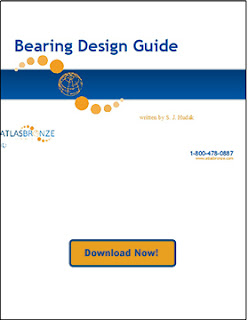1. Identify the particular application from Fig. 6 through 10 in the CBBI Manual.
2. Pick up the recommended value for M from the type of machinery application.
3. A= M(squared)W I D(squared)Z N
W = load in pounds
D = diameter of shaft or bush ID
Z = absolute viscosity ( centipoises)
N=RPM
A = characteristic number
a. Assume an operating temperature
b. Z can be determined for the lube at assumed temperature T(2)
c. A fair approximate of lubricant temperature rise can be made.
Forced feed or pressure lubrication, temperature rise will average between 5 and 10 degrees F, if less oil is supplied bearing will run hotter, thus for other lubricating techniques, such as oil bath, splash feed and ring oiling, lubricant may rise from 1 0 to 1 00 degrees F.
d. After substitution, if "A" falls in the range of .0005 and .50, practical full-film lubrication is possible.
ANALYSIS:
A large value for "N' indicates a heavily-loaded or slow-speed bearing.
Conversely, light loads and high speeds, a very low "A" number will be obtained.
With a light load or no load, eccentricity ratio "e" will be zero and centered.
As the load increases, the journal moves eccentrically.
While eccentricity "e" is increasing, the minimum film thickness (Ho) is decreasing.
Ho = c-e = c (i-e)
If the load becomes great enough, the journal may eventually touch the bearing for this condition:
"e" = c, (Ho) = 0.
Once the bearing characteristic number is determined, a suitable length for the bearing can be determined.
LUBRICATING CONDITIONS
Hydrodynamic Mode:
1. Surface velocity in excess of 25 FPM
2. Coefficient of friction is .001-.005
3. Proper viscosity of lube
4. Proper lube flows
5. Proper design methods
Mixed film/Lubrication Mode:
1. Surface velocity in excess of 10 FPM
2. Coefficient of friction .02-.08
3. Journal BRG goes through all three modes
Boundry Lubrication Mode:
1. Generally slow rotary motion, less than 10 FPM
2. Oscillating motion
3. Coefficient of friction .08-.14
4. Generally grease lubricated
Press Fits or Shrinkage Fits:
1. Generally . 00 1" minimum press fit should be sufficient for ODS up to 3" OD
2. Adjust press fit for bearings through 6" OD to about .002 minimum
3. Following a press fit or shrinkage fit, the bearing ID will close in on the ID by 100% of the press fit allow. Heavier wall bearings will average 60 to 80% close in based on the interference fit allowance.
Bearing Retention Methods:
1. Press fit or shrinkage fit
2. Set screws
3. Woodruff keys
4. Bolted through flange
5. Threaded/screwed bearing
Clearance Allowances:
1. Machined bearings with ground journals for use in steam turbines, generators, etc., usually have a running clearance of. 001 per inch of shaft diameter.
2. Clearances of .0015 through .0035/ inch of diameter are used for grease and solid lube conditions.
Thank you for joining me on this journey. Although we are done with The Bearing Design Guide, don't be sad. I have more exciting things coming in the New Year!
That's all for now. Until 2017 my metal loving friends!
REFERENCES
Mechanical Bronzes (Brass World & Platers Guide, March 1924)
Development in Centrifugal Casting (Metal Industry, Aug. 1939)
Wear and Surface Finish (Gisholt Machine Co. 1947)
Plain Bearing Recommended Practice (AISI April1951)
·Bearing Materials and Properties (Machine Design March 1966)
Cast Bearings (Machine Design March 1966)
The Science ofTribology (CDA London Engineer 1969)
Plain Bearing (Machine Design Jtme 1970)
How to Install Plain Bearings (Power Transmission Nov. 1970)
Plain and Premounted Sleeve Bearings (Machine Design June 197 4)
Copper Alloy Casting Design (CDA United Kingdom)
Boundary Lubricated Sleeve Bearings (Battelle, Columbus, Ohio)
Wear of Cast Bronze Bearings (Incra Aug. 197 6)
Physical Properties of Copper Alloys (Casting Engineering 197 6-77)
Wear Properties of Heavily-loaded Copper-based Bearing Alloys
Power Transmission Design (1994)
When Designing Journal Bearings (Bruce Dunham, Sun Oil Co.)
Bearing Design & Applications (Wilcox, Booser, McGraw-Hill, 1957













